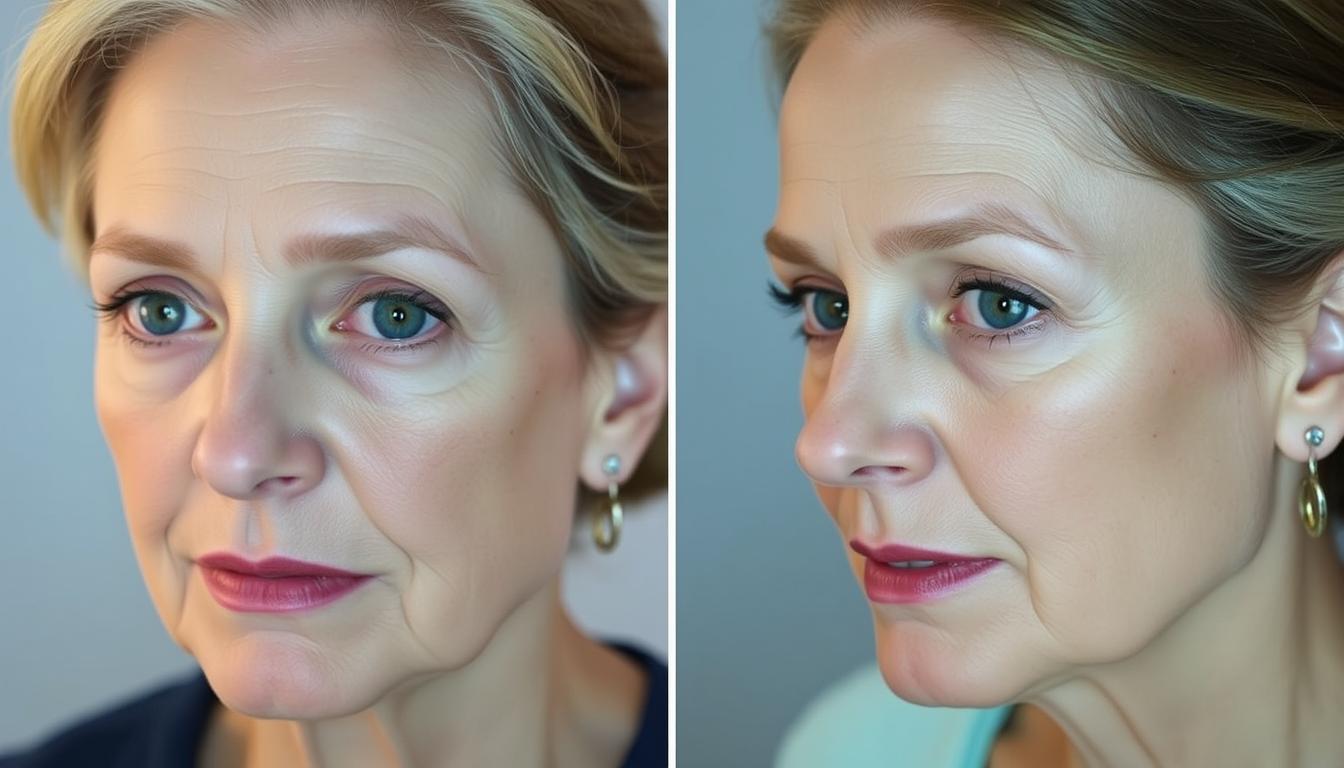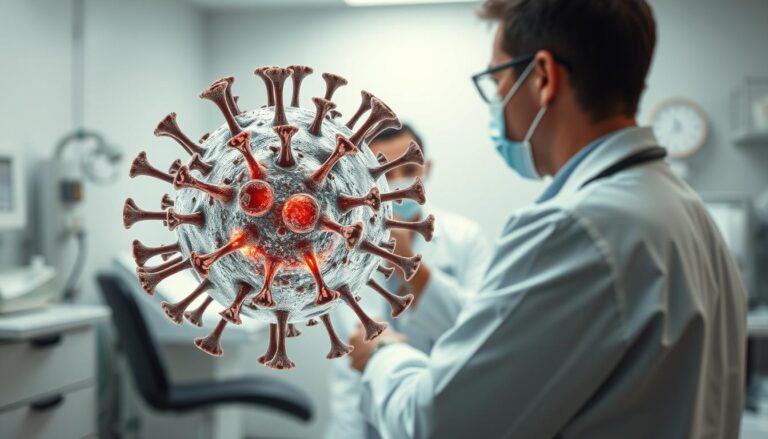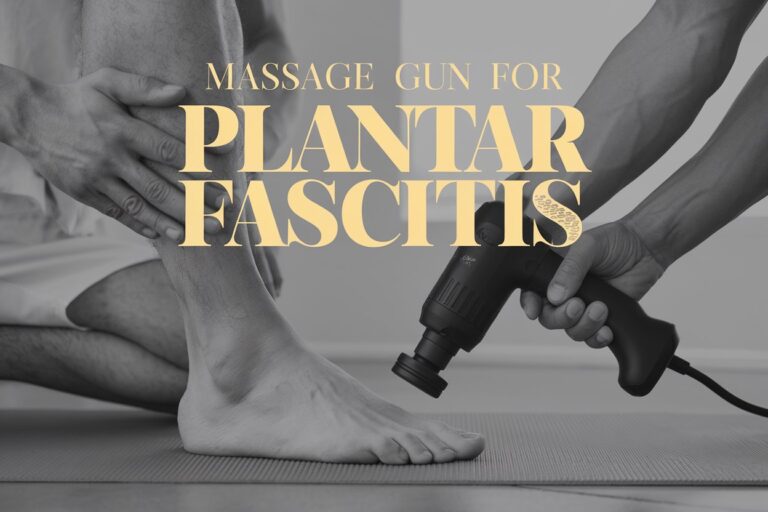Mini Facelift Before and After Transformation

Did you know people from 42 to 75 years old get mini facelifts? This shows it’s popular across many ages. It also shows how well it works.
A mini facelift focuses on the lower face, like the chin and jawline. It’s less invasive than a full facelift. This means smaller cuts and a faster recovery.
Many want mini facelift results for sagging skin and wrinkles. You can see changes as early as 8 days after. It’s great for those who don’t want to miss out on life while recovering.
Both men and women can get a mini facelift to look younger. It can be done with other procedures for even better results. See the amazing mini facelift photos and learn more about it!
Table of Contents
What is a Mini Facelift?
A mini facelift is a cosmetic surgery for those wanting to look younger without a big operation. It tightens skin and shapes the face and neck. This surgery takes about two hours, making it a fast option for those who want quick results.
Definition of Mini Facelift
This surgery uses smaller cuts than a full facelift. It leaves less scarring and heals faster. People can often go back to their normal life in just a week. It’s perfect for those in their 30s to 50s with early signs of aging.
How It Differs from a Full Facelift
The main difference is the surgery’s extent. A full facelift takes longer and needs more recovery time. But, a mini facelift offers subtle changes with less surgery. It’s safer and you can get back to social life faster.
Even though it doesn’t last as long, a mini facelift can still make a big difference. Results can last up to 15 years with good skincare.
Who Needs a Mini Facelift?
Figuring out who might benefit from a mini facelift involves looking at certain traits and signs. It’s perfect for those wanting to refresh their look without big surgery. Let’s see who’s a good fit for a mini facelift and what signs point to it.
Ideal Candidates for the Procedure
People aged 40 to 70 usually look into mini facelifts. They often have mild to moderate sagging skin and jowling. The right candidates have:
- Good skin elasticity and health
- Want subtle yet clear changes in their face
- Are in good health, without big medical issues
- Are ready to follow after-care instructions
Signs You Might Consider a Mini Facelift
Knowing when to get a mini facelift can be key. Look out for these signs:
- Jowls or sagging skin along the jawline
- Loss of definition in the jawline
- Sagging skin in the neck area
- Wanting a younger look but still natural
As people age, their faces can look tired or less bright. A mini facelift can help with this. It can last about seven years, boosting self-esteem and satisfaction with one’s looks.
The Mini Facelift Procedure
The mini facelift is popular for its quick and effective results. It uses less invasive methods for a faster recovery. Knowing the steps and anesthesia options helps prepare for the process.
Step-by-Step Overview
The mini facelift starts with a detailed consultation. The surgeon checks your needs and what you want to achieve. Then, they mark the incision spots for hidden scars.
The surgery uses sedation and general anesthesia for comfort. Surgeons use the SMAS imbrication technique. This method places at least 10 sutures for strength and support.
This approach means less skin cutting and less discomfort after. It also reduces swelling and bruising.
Anesthesia Options for Comfort
Choosing the right anesthesia is key for a comfortable mini facelift. Patients can pick between sedation and general anesthesia. Sedation makes you relaxed but awake. General anesthesia makes you fully asleep.
Doctors focus on your safety and comfort. They work with you to pick the best option based on your health and wishes.
Pre-Treatment Care
Pre-treatment care is key to getting ready for a mini facelift. A detailed consultation with a skilled surgeon helps set clear goals and expectations. This talk ensures patients understand their needs and feel ready for the journey ahead.
Consultation with a Surgeon
The first step is meeting with a board-certified plastic surgeon. They will check if a mini facelift is right for you. You’ll discuss risks, preparations, and what to expect during surgery.
Necessary Lab Tests and Evaluations
Lab tests are often needed before surgery. These tests check your health to make sure you’re safe for the procedure. It’s important to talk about any health issues and stop blood-thinning meds as advised. Keeping your skin and body healthy helps with a smoother surgery and recovery.
Before and After Treatment Pictures
Mini facelift results are clear in before and after photos. These pictures are key to showing the real effects of the procedure. They help people see the changes they can get.
Importance of Visual Evidence
Looking at mini facelift photos helps set realistic expectations. People often see big improvements in how they look. This can make them look 10 to 15 years younger.
These changes not only improve looks but also boost self-esteem and confidence.
What to Expect from Transformational Results
When deciding, people can see big differences in others’ looks. Each person’s face has its own issues, like heavy necklines or extra fat. But, the results usually make people feel more alive.
Also, recovery is quick. Most people can get back to normal in about a week.
Thinking about how body image affects confidence and relationships is important. Topics like positive self-talk can offer more insights. Understanding the transformation process can help people feel more confident on their journey to a better self-image.
Post-Treatment Care
After a mini facelift, proper care is key for a smooth recovery. Following certain guidelines can make your healing faster. Most people take about two to three weeks to start feeling better, with full recovery taking up to a year.
Guidelines for Optimal Recovery
It’s important to follow the right steps for recovery. Here are some key tips:
- Rest and avoid heavy activities the first night after surgery.
- The dressing will be removed the next morning, along with any drains.
- Sutures are usually taken out between five to seven days later.
- Avoid bending, straining, lifting, or intense exercise for two to three weeks.
- Watch for swelling and bruising, which should lessen by the second week.
Managing Discomfort and Swelling
Many people feel some discomfort and swelling after surgery. To help, doctors often give pain meds. Here are some tips for dealing with these symptoms:
- Don’t drive or use machinery while on pain meds.
- Constipation is common; a stool softener can help.
- Emotional changes are normal, especially in the first week, and usually pass.
- Avoid heavy lifting or intense activities for three weeks.
- Don’t take a tub bath until your surgeon says it’s okay.
- Don’t use heating pads to avoid swelling or irritation.
By following these care tips, you can speed up your recovery and get the best results from your mini facelift.
Risks and Complications
Getting a mini facelift has many benefits. But, it’s important to know the possible risks and complications. Knowing these helps patients make smart choices on their cosmetic journey.
Common Side Effects
After a mini facelift, you might face some common side effects. These include:
- Swelling, which usually goes away in a few days.
- Bruising in the treated areas.
- Mild discomfort, which can be managed with pain meds.
These side effects usually get better over time. Most people see big improvements in a week. Knowing about these effects helps set the right expectations for recovery.
Rare but Serious Risks
Even though mini facelifts have fewer risks than full facelifts, it’s still important to know about possible complications. Rare but serious risks include:
- Hematoma formation, which can happen within 24 hours after surgery.
- Infection at the incision sites, needing quick treatment.
- Nerve damage, causing changes in facial feeling that might last.
- Scarring, which is usually small but can be noticeable.
- Loss of circulatory supply, which can slow healing.
Talking openly with your surgeon about these risks is key. This conversation helps plan ways to avoid problems and make sure you’re happy with the results.
Recommended Products for Pre and Post Treatment
Good skincare is key before and after a mini facelift. Using the right products before surgery can make your skin healthier and ready for the procedure. A good routine includes gentle cleansers, quality moisturizers, and sun protection to avoid surgery complications.
Skincare Products to Prepare Your Skin
Start by quitting smoking three weeks before surgery to lower health risks and speed up healing. Get your skin care essentials like moisturizers, chapstick, and pain meds a week before. Brands like Obagi®, GLYTONE, ENVIRON®, and SkinCeuticals offer great products for skin care during this important time.
Products to Aid Recovery
After your mini facelift, there are products to help with healing. Rest on the first day and use Tylenol for pain. Start with clear fluids and move to soft foods as you can.
Watch for signs of trouble like fever, too much bleeding, or vomiting. Stay hydrated and use natural skincare to reduce swelling and aid healing. Follow your surgeon’s advice and avoid nicotine, caffeine, and alcohol for two weeks. For more tips, including dosage and nitric oxide supplements, check this resource.
Alternative Treatments to Consider
Looking to refresh your look? There are many ways to do it without surgery. Options like dermal fillers and Botox offer quick fixes for those wanting a change fast. Each has its own benefits and downsides, so picking the right one is key.
Non-Surgical Alternatives
Non-surgical facelifts can make your skin look better. Here are some popular choices:
- Dermal Fillers: Great for adding volume and shaping, they last up to two years. They’re perfect for younger people with elastic skin.
- Botox: It temporarily smooths out wrinkles, lasting three to six months.
- Laser Treatments: These resurface and tighten the skin, needing about five to seven days to recover.
- Radiofrequency Microneedling: It takes three to four sessions for the best results, improving skin firmness and texture.
- Thread Lifts: Though easy to do, they don’t last long and can have risks like scarring.
Comparison with Other Surgical Options
Non-surgical facelifts and surgical ones have different benefits. Quick fixes give small changes, but a mini facelift offers bigger and longer-lasting results.
| Treatment Type | Longevity | Recovery Time | Effectiveness |
|---|---|---|---|
| Mini Facelift | Up to 10 years | 7-10 days | Significant improvement |
| Dermal Fillers | Up to 2 years | No downtime | Moderate enhancement |
| Botox | 3-6 months | No downtime | Temporary reduction of wrinkles |
| Laser Treatments | 1-2 years | 5-7 days | Improved texture & tightening |
| Thread Lifts | Less than 3 months | No downtime | Short-term results |
Choosing the right treatment depends on your goals, how fast you heal, and what you prefer. Dr. Butler helps each patient find the best option for them, aiming for the best results.
Cost of Mini Facelift
Understanding the cost of a mini facelift is key for those thinking about it. The mini facelift cost changes based on several factors. Knowing these can help with budgeting for the surgery.
Factors Influencing the Price
Several key factors impact the cost of facelift in the USA:
- Surgeon’s Expertise: More experienced, board-certified plastic surgeons charge more.
- Geographical Location: Prices are higher in big cities and rich areas. For example, a facelift in New York City can cost between $20,000 and $80,000.
- Complexity of the Procedure: More complex operations and longer times mean higher costs.
- Anesthesia and Facility Fees: Different types of anesthesia and surgical facilities affect the total cost.
- Pre and Post-Operative Care: Costs for follow-up visits and supplies also add up.
Average Cost in the United States
The cost of facelift in the USA varies widely. A traditional facelift averages around $11,395. Mini facelifts, however, cost between $3,500 and $10,000, making them more budget-friendly. Here’s a detailed breakdown of costs in various cities:
| City | Average Cost Range |
|---|---|
| Los Angeles | $7,000 to $15,000 |
| Miami | $5,000 to $8,000 |
| Dallas | $9,000 to $12,000 |
| Chicago | $7,000 to $15,000 |
| Seattle | $8,000 to $14,000 |
| San Francisco | $10,000 to $50,000 |
Finding Treatment Near Me
Looking for a mini facelift near me can be tough. With more people wanting this procedure, finding the right surgeon is key. Look for local surgeons with the right certifications, lots of experience, and good patient feedback. This way, you’ll have the best chance of a great result.
Researching Local Surgeons
When searching for a surgeon, keep these points in mind:
- Board Certification: Make sure the surgeon is certified in plastic surgery.
- Experience: Choose surgeons with a lot of mini facelift experience.
- Patient Testimonials: Check what past patients say to see if they’re happy.
- Before and After Photos: Look at their past work to see what they can do.
Social media is also helpful. Many people share their experiences and connect with surgeons on Instagram and Facebook. This lets you see real results and learn more about the surgery.
Questions to Ask During Consultations
During your consultations, ask important questions to feel sure about your choice:
- What surgical techniques do you use for mini facelifts?
- What can I expect during the recovery period?
- How many mini facelifts have you performed?
- What are your strategies for managing post-operative discomfort?
Getting this info helps you make smart choices for your rejuvenation journey. Talking to a skilled professional first can help you get the results you want and have a smooth recovery.
Also, check out essential insights on therapy options that might help with your facelift journey. This ensures a complete approach to your health and beauty goals.
Aftercare Follow-Up Visits
After a mini facelift, taking good care of yourself is key. Mini facelift follow-up visits help your surgeon check on your healing. They can spot any issues and adjust your care plan as needed. These visits are crucial for the best results.
Importance of Post-Operative Check-Ups
Early check-ups are very important. Your surgeon will look at your incisions, swelling, and how you’re healing. They help by:
- Adjusting your pain meds if needed.
- Cleaning your incisions to prevent infection.
- Offering tips on skincare and lifestyle changes.
Timeline for Follow-Up Appointments
Patients usually have follow-ups at set times after surgery. Here’s a general schedule:
| Day | Follow-Up Activity |
|---|---|
| 2 Days | First check-up; checking pain and removing bandages. |
| 7 Days | Looking at incisions; might remove stitches. |
| 1 Month | Checking swelling and recovery; adjusting skin care. |
| 3-6 Months | Checking long-term results and ongoing care. |
Staying healthy during recovery is important. Following your surgeon’s advice helps keep your mini facelift looking great. Don’t skip these post-operative care visits for the best healing and results.
Emotional Aspect of the Transformation
The journey after a mini facelift is more than just physical changes. Patients feel a range of emotions during recovery. Understanding these feelings is key. The mini facelift’s benefits go beyond looks, improving mental health.
Psychological Benefits of a Mini Facelift
Many feel more confident and self-assured after a mini facelift. Seeing positive reactions from others boosts their self-worth. This feedback surprises and satisfies patients, making them happier and more social.
However, early recovery can be tough. Swelling and bruising may make patients feel uncomfortable. But, as healing progresses, these feelings often lessen. Talking openly about these emotions helps.
Adjusting to Your New Look
Getting used to a new look takes time and understanding. People may feel anxious, impatient, or even miss their old look. Building a support network and using mind-body techniques can help.
It’s important to talk to loved ones about how you feel. This sharing can offer support and understanding. Professional help can also be a great resource for managing complex emotions.
For more on how emotions affect personal satisfaction, check out emotional effects related to personal transformations. Recognizing the emotional side of plastic surgery is key to a successful recovery. It leads to a better self-image.
| Emotion | Description | Management Strategy |
|---|---|---|
| Excitement | A feeling of joy and anticipation about the new appearance. | Focus on the positive aspects of the change. |
| Anxiety | Nervousness about the recovery process. | Maintain a dialogue with your support system. |
| Regret | Doubt about the decision post-surgery due to initial recovery difficulties. | Recognize these feelings are temporary; engage in self-care and mindfulness. |
| Impatience | Frustration when waiting for full recovery and results. | Set realistic expectations and celebrate small progress. |
| Depression | Low mood that may arise due to physical changes and recovery stress. | Consider counseling or professional support. |
Patient Testimonials
Many people have chosen mini facelifts to improve their looks. They’ve seen big changes that boost their confidence. Patients say they feel new and look younger, thanks to doctors like Dr. Mustoe and Dr. Sinno.
Success Stories from Real Patients
Mini facelifts have helped with jowls, cheeks, and jawlines. One patient noticed a big change in her smile and confidence. These mini facelift reviews show how well it works, especially when combined with other treatments.
Before and After Experiences
Patients share their before and after photos to inspire others. The changes are clear, showing off natural beauty without looking fake. The quick recovery time means they can get back to life fast. These stories make the mini facelift a popular choice for many.
FAQ
What can I expect from mini facelift before and after photos?
How long does the recovery time typically take after a mini facelift?
What is the average cost of a mini facelift?
How does the mini facelift procedure work?
Who are the ideal candidates for a mini facelift?
What should I do for pre-treatment care?
Are there any common side effects of a mini facelift?
What skincare products should I consider pre and post-treatment?
What are some non-surgical alternatives to a mini facelift?
How do I find a reputable local surgeon for a mini facelift?
Why are follow-up visits after a mini facelift important?
What psychological benefits can I expect from a mini facelift?
Can I find reviews from patients who have undergone a mini facelift?





